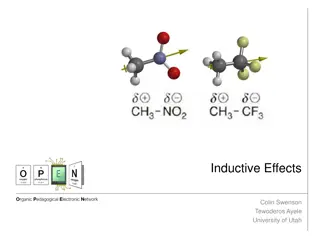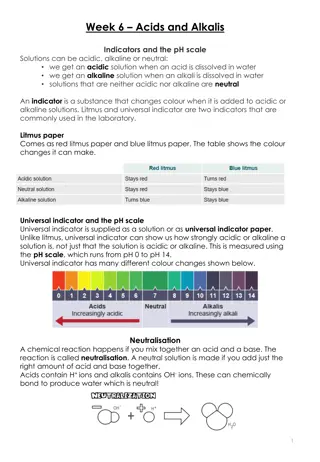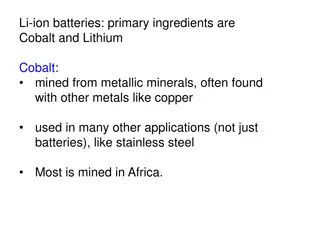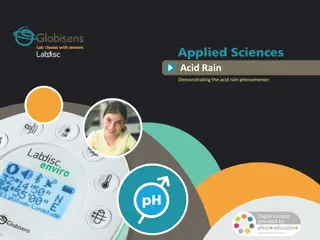Aspirin Assay by Direct Acid-Base Titration Experiment Overview
Exploring the process of assessing aspirin purity through direct acid-base titration using sodium hydroxide as a standard solution. The experiment includes details on aspirin properties, dosage, acidity, decomposition, and metabolism. Key aspects covered include the aim of the experiment, the princi
5 views • 15 slides
Understanding Butter: Types, Classification, and Neutralization Process
Butter is a fat concentrate obtained by churning cream, with specific requirements as per regulations. It comes in various types such as pasteurized cream, ripened cream, salted, unsalted, sweet cream, and sour cream butter. The neutralization process involves reducing cream acidity using lime or so
0 views • 5 slides
Understanding Ocean Acidification: Impact on Coral Reefs
Ocean acidification is the process where oceans become more acidic due to excessive carbon dioxide absorption. Human activities like deforestation and vehicle emissions contribute to this phenomenon. Coral reefs are crucial as many ocean species rely on them for survival. The pH scale measures acidi
0 views • 18 slides
Understanding the Physico-Chemical Properties of Cream
This informative material delves into the physico-chemical properties of cream, covering aspects such as viscosity, whipping quality, titratable acidity, specific gravity, and factors influencing viscosity. It discusses the influence of fat content, temperature, homogenization, cooling, aging, and c
0 views • 8 slides
Understanding Cheese Additives and Preservatives in Dairy Technology
Explore the use of various additives and preservatives in cheese production, such as salts to restore calcium balance, inhibit undesirable organisms, common salt for flavor and preservation, acidulants to increase acidity, colorants to enhance appearance, and flavorings. These additives play crucial
0 views • 9 slides
Extreme Environments and Extremophiles: Surviving the Unthinkable
Extremophiles are organisms that thrive in extreme conditions such as high temperatures, acidity, salinity, and more. They have unique adaptations like extremozymes and can withstand harsh environments where life was once deemed impossible. Types include psychrophiles and Firmicutes, showcasing rema
2 views • 24 slides
Exploring pH Levels in Common Drinks
This activity aims to compare the acidity levels of fizzy drinks and alcoholic beverages by measuring their pH using a SensorLab pH sensor. Students are introduced to the concept of acidity, the pH scale, and the importance of pH in determining whether a substance is acidic or alkaline. Theoretical
0 views • 22 slides
Understanding pH Scale and Hydronium Ion Concentration
The pH scale is a logarithmic measurement that indicates the acidity or alkalinity of a solution based on the concentration of hydronium ions. pH values range from 0 to 14, with 7 being neutral. Lower pH values indicate acidity, while higher values indicate alkalinity. This scale provides a convenie
0 views • 104 slides
Understanding the Impact of Acid Rain on Ecosystems
Investigate the effects of acid rain caused by fossil fuel combustion on water acidity, plant life, animals, and structures. Learn how nitrogen oxides and sulfur dioxide create acid solutions in the atmosphere, affecting watersheds and sensitive ecosystems. Explore the devastating consequences of ac
1 views • 20 slides
Understanding Milk Freshness and Quality Control
Milk freshness is crucial for maintaining optimal nutrient composition and preventing excessive acidity due to microbial activity. Various tests and analyses are conducted to assess the freshness and appropriateness of milk for further processing, with titration methods being a common approach for m
2 views • 7 slides
Understanding the Hammett Equation in Chemical Reactions
The Hammett equation explores how substituents influence the dissociation of benzoic acid, affecting its acidity. By quantifying this influence through a linear free energy relationship, the equation helps predict the impact of substituents on different processes. Through parameter definitions and m
0 views • 9 slides
Understanding Acids and Bases: pH Scale Explained
Exploring the pH scale, this content delves into the fundamentals of acidity and alkalinity, covering what pH stands for, the inventor of the pH scale, reactions when acids and bases combine, and where the weakest acids and bases are found on the pH scale.
0 views • 7 slides
Understanding Quality Characteristics of Good Olive Oil
Discover the essential quality characteristics of good olive oil, including factors affecting its quality, basic composition, and parameters influencing its overall acceptability. Learn about the importance of attributes such as free fatty acidity, peroxide value, and sensory scores in determining o
5 views • 12 slides
Understanding Inductive Effects in Organic Chemistry
Inductive effects play a crucial role in the reactivity and properties of organic molecules. This phenomenon involves the withdrawal or donation of electron density due to differences in electronegativity, impacting acidity, stability, and interactions with other molecules. Explore how inductive eff
0 views • 7 slides
Understanding Butter: Definition, Standards, and Composition
Explore the definition of butter according to FSSAI standards, including its composition, permitted additives, and classifications based on acidity, salt content, end-use, and manufacturing practices. Discover the nutritional composition and fatty acid profile of butter along with essential informat
0 views • 10 slides
Understanding Acids, Alkalis, Indicators, and the pH Scale
Solutions can be acidic, alkaline, or neutral depending on whether an acid or alkali is dissolved in water. Indicators like litmus and universal indicator help determine acidity or alkalinity. The pH scale measures this, with 7 being neutral. Neutralization reactions occur when an acid and a base re
0 views • 5 slides
Understanding Peptic Ulcer Disease and Dyspepsia: Causes and Pathogenesis
Peptic ulcer disease and dyspepsia are common gastrointestinal conditions. Dyspepsia presents with upper abdominal pain and may or may not be associated with peptic ulcers. The most prevalent causes of dyspepsia include non-ulcer dyspepsia, GERD, and peptic ulcers. Peptic ulcers account for a signif
0 views • 24 slides
Understanding the Physico-Chemical Properties of Milk - Part 1 by Dr. Sushma Kumari
Physical and chemical properties of milk including its physical state, acidity levels, pH, density, freezing point, color, and flavor are discussed in detail in this informative article by Dr. Sushma Kumari from Bihar Animal Sciences University. Key points covered include the nature of milk constitu
0 views • 7 slides
Understanding Aldehydes and Ketones in Organic Chemistry
Aldehydes and ketones are compounds that contain carbonyl groups (>C=O). Aldehydes have the CO group linked to either two hydrogen atoms or one hydrogen atom and one alkyl or aryl group, while ketones have the CO group linked to two alkyl or aryl groups. The structure of the carbonyl group is charac
0 views • 26 slides
The Art of Pickling: History, Types, and Techniques
Pickling is a traditional food preservation method involving fermentation in brine or marination in acidic solutions. With origins dating back 4000 years to India, pickling has evolved to include various types like brined dill pickles, relishes, and fruit pickles. This article explores the history,
0 views • 18 slides
Exploring the pH Levels of Common Drinks
This experiment focuses on comparing the pH levels of fizzy drinks and alcoholic beverages by formulating and testing hypotheses using a Labdisc pH sensor. The introduction explains acidity, heartburn, and the concept of pH, while the theory introduces the pH scale and examples of acidic and alkalin
0 views • 22 slides
Understanding Gastrointestinal Agents: Acidifying Agents, Antacids, Saline Cathartics
Gastrointestinal agents such as acidifying agents, antacids, and saline cathartics are used to manage gastrointestinal disturbances. Acidifying agents like Hydrochloric Acid aid in gastric digestion, while antacids help reduce gastric acidity. Saline cathartics are used as laxatives. Achlorhydria, a
0 views • 36 slides
Understanding Acid-Base Physiology in the Human Body
Acid-Base homeostasis plays a crucial role in maintaining the optimal acidity of body fluids through a balance of chemical buffers and physiological processes. Disruptions in this balance can lead to various effects on the central nervous system and ionized calcium levels. Understanding the concepts
0 views • 21 slides
Understanding pH Scale and Acidic Substances
Explore the pH scale and identify acidic substances by placing them correctly. Understand the acidity levels of common substances like water, orange juice, stomach acid, baking soda, and drain opener. Test your knowledge with interactive images depicting pH levels.
0 views • 8 slides
Environmental Impact of Cobalt Mining in Blackbird Mine Area
Cobalt mining activities in the Blackbird Mine area have had a significant impact on the local ecosystem, particularly on salmon populations in Panther Creek. The mining operations led to increased acidity in waterways, resulting in Acid Mine Drainage and the mobilization of toxic metals like copper
0 views • 12 slides
Understanding Alcohols: Classification, Nomenclature, and Uses
Alcohols are organic compounds with an -OH functional group attached to a carbon atom. They are classified as primary, secondary, or tertiary based on the carbon the -OH group is bonded to. The IUPAC nomenclature for alcohols involves changing the ending of an alkane to -ol. Alcohols like methanol,
0 views • 11 slides
Understanding Water Quality Parameters and Characteristics
Water quality encompasses physical, chemical, and biological characteristics that determine its suitability for various uses. Physical parameters like turbidity, taste, odor, color, and temperature affect sensory perception. Chemical parameters such as pH, acidity, alkalinity, and hardness relate to
0 views • 26 slides
Exploring Extreme Environments for Signs of Life Beyond Earth
Life thrives in extreme environments on Earth, with organisms known as extremophiles adapting to harsh conditions like heat, cold, darkness, acidity, and lack of oxygen. Scientists speculate about the possibility of life on other planets like Mars, focusing on Jupiter's moons as potential habitats.
0 views • 17 slides
Factors Affecting Acid Strength: Atoms, Size, Hybridization, and Electronegativity
The strength of acids is influenced by various factors such as the atom on which the negative charge of the acid's conjugate base rests, atom size, hybridization, and electronegativity. The stability of negative charges on atoms, atom size allowing charge delocalization, preferred orbital types for
0 views • 23 slides
Study of Distillation Characteristics of Kerosene and Petroleum Solvents
This research proposal aims to investigate the distillation characteristics of Kerosene (IS 1459) and Petroleum Hydrocarbon Solvents (IS 1745) to differentiate between them. With overlapping boiling points, it is crucial to determine the 50% and 95% volume recovery temperatures in both standards to
0 views • 11 slides
Understanding Acid Rain and Its Environmental Impact
Exploring the phenomenon of acid rain, this activity investigates the effects of fossil fuel emissions on water acidity. By using a pH-meter sensor, participants create hypotheses and conduct experiments to understand what determines the pH of acid rain. Theoretical insights reveal how nitrogen oxid
1 views • 20 slides
Understanding pH Calculations for Acids and Bases in Water
Acids and bases play crucial roles in chemical reactions by involving the transfer of protons. This lecture explains the definitions of acids and bases, general acid-base reactions in water, and how the pH scale is used to measure the acidity or basicity of a solution. It covers how acids and bases
0 views • 42 slides
Exploring the King George Wine Society and Palate Education
Immerse yourself in the world of the King George Wine Society, founded by Bill NSV Jacques Recht, a renowned winemaker. Discover the intricate elements that form the structure of wine, including acidity, alcohol, body, sweetness, and tannins. Join engaging events to educate your palate on body, flav
0 views • 24 slides
































